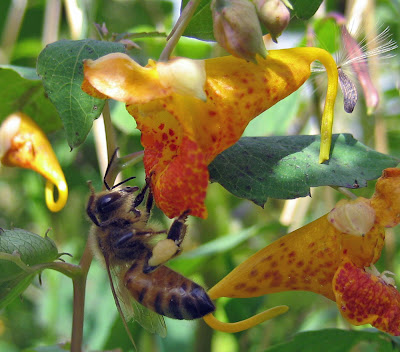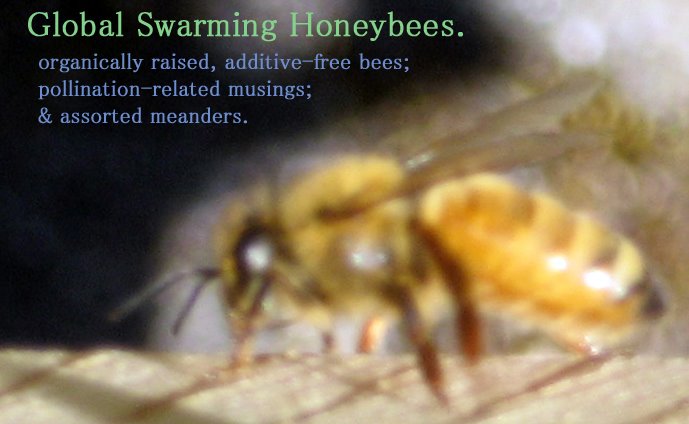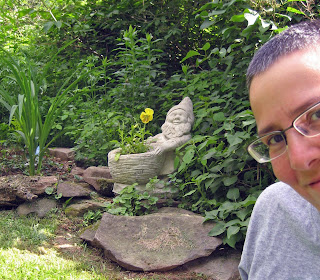MY FRIEND JOHN WRITES
I'm reading Don Quixote—
“In the fissures of rocks
and the hollows of trees
diligent and clever bees
established their colonies,
freely offering to any hand
the fertile harvest of their sweet labor.”
I wonder if they freely offered.
10.30.2007
Found Poem
10.29.2007
Bulbs, Bees, and Muddy Acts of Faith
The weather is finally turning cold (or cold-ish) and hard frost has come, weeks past its due date, zapping the remaining color from the fields. Pink milkweed blossoms are just a memory now, blown to the wind on silken white horsetails that spring from cracked brown pods. Incandescent goldenrod blossoms have gone to cloud-like seed. Jewelweed, burdock, and all the other flowers the bees worked so diligently all summer have died back or become, truly, ghosts of their former selves.
Thankfully, the borage in the herb bed continues to provide a bit of sustenance, and with daytime temperatures continuing to provide days warm enough for the honeybees to venture out, the borage blossoms are where it’s at, bee-wise. What a gift to see and hear the honeybees work in these last days of October. What a strange and haunting gift.
This weekend, our answer to the sadness of autumn was to plant spring bulbs. Wren and I got 100 Siberian squill bulbs and 200 crocus bulbs in the ground after hours of digging around in the cold mud. Both bloom in early spring, and should provide a welcomed pollen source for the bees once the weather is warm enough for them to start flying and before an abundance of other pollen sources have become available.
I remember the indescribable thrill, last spring, of watching our newly hived honeybees feverishly working the measly bed of ten or twelve crocuses in front of the house. I am hopeful that at least one or two of our three colonies will survive the winter, if winter ever comes. And I’m eager to visit with the bees next spring and see them making use of the squill and other gifts of garden and field.
Planting these bulbs, for me, is a leap of faith: that spring will come again, that our bees will live to see it, and that we’ll have the time and presence of mind to immerse ourselves fully in the mesmerizing wonder of it all.
10.26.2007
Honeybee Reconnaissance
The bees never miss a trick. You put something out on the hood of the car or carry a tool up to the field or lay a sweater on the lawn, and they're on it. Perpetual reconnaissance. This one's surveying the beekeeping equipment, to make sure everything's in order.
10.18.2007
Jewelweed
I first came to love jewelweed as a kid at camp. Also known as "touch-me-not," the pods of this lovely, commonplace plant "explode" when touched, posing an irresistible temptation to break the vivid commandment engendered in the plant's name.
Here's a seed and the spring-like mechanism that sends the seeds catapulting far and wide—a most ingenious and dramatic mechanism of seed dispersal. Even now—many years removed from being a kid at camp—I revel in the child-like pleasure of prodding fat jewelweed pods to make them burst.
Even now—many years removed from being a kid at camp—I revel in the child-like pleasure of prodding fat jewelweed pods to make them burst.
The honeybees (and bumblebees, and hummingbirds) revel in the jewelweed, too, energetically working its blossoms from July through the end of August. This summer, their labors brought a bumper crop of popping pods disbursing the seeds far and wide.
 The bee has to go pretty deep inside the fluted flower to reach the nectar spur.
The bee has to go pretty deep inside the fluted flower to reach the nectar spur. When it does so, it rubs against the the cluster of stamens with white anthers that you can see here. This transfers pollen onto the bee's head and back. Ingeniously, the ovary is located just above the anthers, so as the bee moves from flower to flower to gather nectar, it transfers the pollen from one flower to the ovaries of another.
When it does so, it rubs against the the cluster of stamens with white anthers that you can see here. This transfers pollen onto the bee's head and back. Ingeniously, the ovary is located just above the anthers, so as the bee moves from flower to flower to gather nectar, it transfers the pollen from one flower to the ovaries of another. Here's what the bee looks like when it's working the jewelweed. It took me a few weeks to figure this out. At the hives, I'd see bees coming in with these white stripes on their backs. I didn't realize it was pollen—I figured my queen had mated with some odd-looking drones.
Here's what the bee looks like when it's working the jewelweed. It took me a few weeks to figure this out. At the hives, I'd see bees coming in with these white stripes on their backs. I didn't realize it was pollen—I figured my queen had mated with some odd-looking drones. Here are some shots of the bees combing the pollen off their heads and backs, and transferring it to their pollen baskets. Note the wonderful variations in the blossoms' color and patterns.
Here are some shots of the bees combing the pollen off their heads and backs, and transferring it to their pollen baskets. Note the wonderful variations in the blossoms' color and patterns.


 Jewelweed is, by the way, a native plant, possessing some pretty interesting properties, including great-tasting seeds.
Jewelweed is, by the way, a native plant, possessing some pretty interesting properties, including great-tasting seeds.
10.15.2007
Blog Action Day/Thought of the Day
“What we refer to as nature or the ‘environment’ or the wild world is our endangered habitat and home, and we are its problem species. Living in it well with each other and with all the other beings is our ancient challenge. In this time of New World Disorder, we need to find the trick of weaving civilized culture and wild nature into the fabric of the future. This will be both art and science. We can take heart, however, from the fact that the actual physical world sets conditions that are some of the strongest guards against ignorant extremism and fanaticism. ‘Get real! Get a life!’ is the daily message of Mother Nature.—Gary Snyder, “Ecology, Literature, and the New World Disorder”
Stay the course, my friends.”
10.05.2007
10.03.2007
10.02.2007
10.01.2007
Portulaca Honeybee
Autumn has been gentle so far, with no hard frost as of yet and none predicted for the upcoming week. Though there's been significant die-back of the bees' forage plants, there are still a few decent stands of goldenrod and a great deal of aster to continue provisioning the bees for winter. The weather has been balmy and the bees have been foraging intensively in their continuing effort to pack away as much nectar and pollen for winter as they can. (My beekeeper mentors tellme a colony needs at least 60 pounds of honey to survive the winter; an inconceivable amount of work when you consider the size of a honeybee. Happily, all three of my hives appear to have attained the necessary stores.)
This weekend, I observed the bees foraging on borage, sunflower, black knapweed, ornamental (late-blooming) milkweed, zinnia, squash blossoms, and salvia, along with aster and goldenrod.
I was particularly intrigued to see a bee working the portulacas I planted early this summer near the front of the house. Though I have seen bees scope out these flowers throughout the summer (and occasionally collect dew drops from the petals), I've never seen a bee gather nectar or pollen from these plants—probably because better options abounded. But with the forage menu diminishing daily, this busy bee put aside any scruples she may have had about delving into the portulaca and literally immersed herself in the task, till she was dusted from head to tail with pollen.










